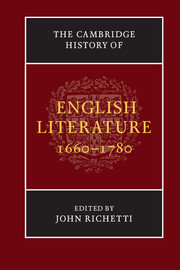Book contents
- Frontmatter
- Introduction
- PART I LITERARY PRODUCTION AND DISSEMINATION: CHANGING AUDIENCES AND EMERGING MEDIA
- PART II LITERARY GENRES: ADAPTATION AND REFORMATION
- 5 Restoration and early eighteenth-century drama
- 6 Dryden and the poetic career
- 7 Political, satirical, didactic and lyric poetry (I): from the Restoration to the death of Pope
- 8 Eighteenth-century women poets
- 9 Systems satire: Swift.com
- 10 Persistence, adaptations and transformations in pastoral and Georgic poetry
- 11 Political, satirical, didactic and lyric poetry (II): after Pope
- 12 Drama and theatre in the mid and later eighteenth century
- 13 Scottish poetry and regional literary expression
- PART III LITERATURE AND INTELLECTUAL LIFE: THE PRODUCTION AND TRANSMISSION OF CULTURE
- PART IV LITERATURE AND SOCIAL AND INSTITUTIONAL CHANGE
- PART V LITERARY GENRES: TRANSFORMATION AND NEW FORMS OF EXPRESSIVENESS
- PART VI CONCLUSION
- Chronology
- Bibliographies
- Index
- References
8 - Eighteenth-century women poets
from PART II - LITERARY GENRES: ADAPTATION AND REFORMATION
Published online by Cambridge University Press: 28 March 2008
- Frontmatter
- Introduction
- PART I LITERARY PRODUCTION AND DISSEMINATION: CHANGING AUDIENCES AND EMERGING MEDIA
- PART II LITERARY GENRES: ADAPTATION AND REFORMATION
- 5 Restoration and early eighteenth-century drama
- 6 Dryden and the poetic career
- 7 Political, satirical, didactic and lyric poetry (I): from the Restoration to the death of Pope
- 8 Eighteenth-century women poets
- 9 Systems satire: Swift.com
- 10 Persistence, adaptations and transformations in pastoral and Georgic poetry
- 11 Political, satirical, didactic and lyric poetry (II): after Pope
- 12 Drama and theatre in the mid and later eighteenth century
- 13 Scottish poetry and regional literary expression
- PART III LITERATURE AND INTELLECTUAL LIFE: THE PRODUCTION AND TRANSMISSION OF CULTURE
- PART IV LITERATURE AND SOCIAL AND INSTITUTIONAL CHANGE
- PART V LITERARY GENRES: TRANSFORMATION AND NEW FORMS OF EXPRESSIVENESS
- PART VI CONCLUSION
- Chronology
- Bibliographies
- Index
- References
Summary
If every eighteenth-century writer came to London carrying a play in his or her hand-baggage, every writer seems to have had pounds of poetry dating back to childhood stashed in bureau drawers. The earliest publications of most eighteenth-century writers are individual poems, and it is often forgotten that the first substantial, even book-length, publication of many writers known today as novelists or playwrights was a volume of poetry. Statistical studies of women writers by Judith Stanton reveal that poetry was women's most popular literary form, and she calculates that 263 women published poetry between 1660 and 1800 (in comparison, she tallies 201 women who published novels). Until 1760, however, the average number of women publishing poetry in a decade was 7; the figures Stanton gives for the next decades are 1760s: 19; 1770s: 36; 1780s: 55; and 1790s: 64. Roger Lonsdale asserts that in the first decade of the eighteenth century only two women published collections of their poetry, while in the 1790s more than thirty did. These figures do not really indicate just how much poetry women were writing or how many women were writing poetry. For instance, we are lucky to know about Jane Brereton, who as ‘Melissa’ carried on a verse correspondence in The Gentleman's Magazine in the mid 1730s, and only eight of Judith Cowper Madan's surviving poems have been published. In the eighteenth century, one was in a periodical, four in fashionable collections and one in her son Martin's Hymn Book (1763). The poetry of Susanna Blamire, among others, was published posthumously, and, because she published so often in periodicals, we will probably never know all the poems Mary Robinson wrote.
- Type
- Chapter
- Information
- The Cambridge History of English Literature, 1660–1780 , pp. 209 - 234Publisher: Cambridge University PressPrint publication year: 2005
References
- 3
- Cited by

